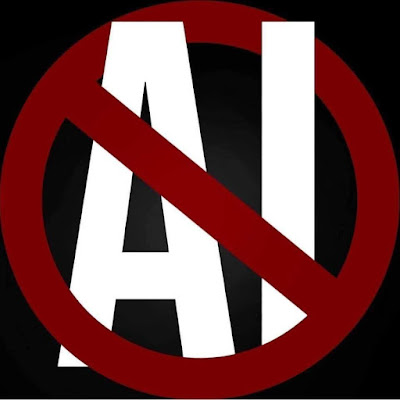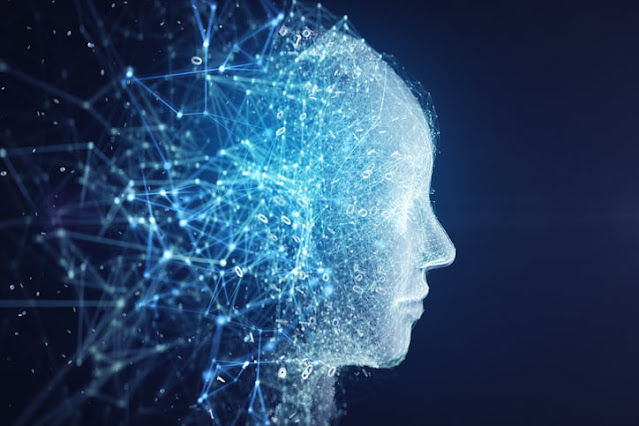NO TO ARTIFICIAL INTELLIGENCE IN ART! (ENGLISH VERSION)
Following a contact with a journalist, I had to gather my arguments about the use of Artificial Intelligences in art.
I have tried to structure these arguments by chapter to make it easier for you to find the points that interest you.
Have a good reading!
---------------------------------------------------------
In recent months
Artificial Intelligence has made a serious entry into the art world,
through software such as Midjourney, Stable Diffusion or DALL-E,
which allows people to create their own images from prompts (textual
descriptions).
Following this first introduction of AI, many artists have risen up to defend their rights against a program that is immoral and breaks the law in many countries.
Following the use, by the Michel Lafont and Tor publishing houses, of images created by Midjourney to illustrate their books to the detriment of artists, and following a crowdfunding to generate a new, more powerful and even more immoral AI: UnrestrictedAI Art Powered bythe Crowd, artists from all over the world are trying to regroup to fight for their rights and to warn of the consequences that such a change of paradigm could bring for society and humanity.
Here are the different points:
. About AI Art Generators:
These AIs operate through a database of works by past and present artists, without their consent, even though these works are not free of rights. It is therefore an artist-bot that plunders and plagiarises the work of other artists without any impunity. No royalties are paid, no credits respected.
Another problematic point is that these programmes are paid for. This raises other questions: who gets the profits from this lucrative activity? What does it finance? And so on.
. Regarding its impact on artists:
At the professional level: once again, the means of production are accelerated, at lower cost, at the service of private companies and to the detriment of a potentially gigantic number of people. No artist can be profitable compared to an artificial intelligence.
This leads to unfair competition both in the professional sphere and in art competitions, which are important in an artist's career. For example, an artist who used Midjourney to create a work won first prize in an art competition: (https://www.lebigdata.fr/midjourney-concours-art)
. Concerning society and humanity:
- These image creation programs are not just tools, they embody a paradigm shift in creation that could cost us dearly.
Here is an anecdote to introduce my arguments (thanks Mina Mond for the anecdote !)
British Airways has realised that more and more incidents are occurring in relation to autopilot (minor at the moment).
Pilots who relied more and more on this technology are losing some of their automatisms in cases where manual flight is the only solution. British Airways therefore recalled retired pilots who had not flown or had flown very little with such efficient autopilots to re-teach manual flight to current pilots.
We can see from this anecdote that when we outsource a skill, we lose it, like a muscle we no longer train. The use of an AI to create images considerably transforms our creative process and our relationship to creation. Our creative process is fed by inspirations, by our cultural and artistic education, by experiences and emotions specific to a person. These inspirations and other elements pass through the filters of the human psyche which are specific to each person and result in creation: something personal to that psyche because it is reworked by a particular and individual system of thought.
AI generator, through the prompt text it imposes, short-circuits the psychic processes intrinsic to artistic development.
On the one hand, because it forces the individual to function in words, whereas we know that our unconscious, from which creativity stems, functions in images (cf. the concept of sublimation, which certainly stems from psychoanalysis but has been taken up by psychology, and is still relevant today). There is therefore a nonsense here. This is the point that marketing has understood very well in order to influence our thoughts, our feelings and ... our consumption.
On the other hand, because the passivity that pushes us to adopt this technology leaves no room for imagination and creativity since a result is directly proposed. It is no longer the slow and laborious psychic process we mentioned earlier that is underway but an immediate result. I will illustrate this point with an example: when a person reads a book, he or she will create a mental representation of the characters, the places, the story. If this person sees an adaptation of this story in film after reading the book, his or her own mental representations will persist and, in the more or less long term, cohabit or merge with the images in the film. Whereas, if a person sees the film first and then reads the book, the mental images that will accompany the reading will be those of the film (i.e. ready-made images) since they are already embedded in the memory and the unconscious. It is much cheaper for the mind to use this already present response.
Yoann Lossel, a French painter, wrote on his Facebook wall: "Art is not only an object of pleasure to satisfy a spectator, it is a complete process which implies to put in motion one's intellect, senses, emotions and to constitute a coherent corpus by gathering this whole. Not everyone is capable of building up this coherent body of work - which, like all work, requires experience - but everyone, one day, tries it and takes pleasure in creating."
Between the creative act of an artist and the use of an AI, we can clearly see that the psychic and cognitive processes at work are significantly different.
Creativity is far from being a gift, it needs to be stimulated. If human creativity can no longer be expressed in its fundamental exercise of artistic creativity, is there not a risk of weakening human creativity in general and its ability to imagine, to think outside the box to solve a life problem or a conflict to mention only these examples, because they rely on the same resources: those of finding, inventing, creating another way, a solution (specific to each person).
- For reasons that do not need to be developed, this will be an ecological disaster.
- In the perspective where the artist, in order to be profitable, will have to adapt to these new requirements and to this competition, non-AI art will become the privilege of those who do not need to earn a living and who will have the leisure to be able to practice without constraint. In other words, non-AI art will become the privilege of those who are 'well born'.
- AI, so far, has been constructed in such a way that it does not represent certain subjects such as nudity. There are also ethnic biases.
Regarding the fact that AI is a tool like any other:
As we have seen in the previous paragraph, it is important to characterise tools and not to confuse them. All tools do not fall into the same category, even if they belong to the same class, they are not intermediaries of the same forces and we do not delegate the same tasks. A pencil and a computer are tools, but they do not have the same impact on our civilisations.
Comparing the arrival of AI in art to the arrival of photography is a tempting parallel - and even interesting because we have precise documentation of the time, a record to stand back on - but it does not seem relevant to me. The camera disrupted a figurative approach in search of hyperrealism, but we are talking about a stylistic revolution. The camera is not a tool for producing art, it was not designed for that. The camera is a medium in the strict sense, which can be used to produce a work of art. A tool that does not have a database to draw from, that does not compose by having ingested the various rules of composition, that does not have a subject (the AI generator, has, in a way, subject matter. He organizes it according to your request). Once you have the camera at the end of your arm, you have to use your imagination and give an intention to this moment until you reach your ideal mental representation. Photography is an exploration of perception and the gaze during which the photographer is constantly in touch with his inner self.
The Function of Art is not consistent with the use of AI:
- Art has always had a social function, ever since it first appeared alongside man. It allows us to share representations, emotions and fears. It is a language of human for human. It is a medium of communication. The intervention of AI hinders this function.
- It is an element that reflects a time, a particular era. Hence the history of art. Art speaks of our progress and our questioning, of our development (it contains collective and unconscious memories). It speaks on several scales: from an individual point of view, but also from a group or societal point of view. Art has always served to commemorate events, to forge memories, to glorify individuals. It plays a role in the construction of the identity of individuals and societies.
- Art is also a transmission of knowledge and techniques that individuals pass on from generation to generation. However, since the industrial revolution, there has been a real and significant loss of know-how in the arts and crafts. This will only be accentuated by the arrival of AI.
- Art and creation, as shown by art therapy, have many beneficial effects, such as work on the subconscious, greater self-confidence and self-knowledge. But will these effects still be present with the incorporation of AI into the equation? Particularly with regard to self-knowledge, self-confidence and self-esteem when one is dependent on an object outside of oneself.
Thank you for your attention!
Huxley said: "Art also has its morality, and many of the rules of this morality are the same as, or at least analogous to, the rules of ordinary ethics."
"We shall meet in the place where there is no darkness". Orwell

.jpg)

Thank you for the creative article that made me hate artificial intelligence :))
ReplyDeleteArticles like this are important because they guide us to the importance of art in reminding us of our humanity, art helps us to understand ourselves and the world around us and It can be a way to explore our own emotions and experiences.
Let's quote part of what Yoann said "Art is a complete process which implies to put in motion one's intellect, senses, emotions and to constitute a coherent corpus by gathering this whole"